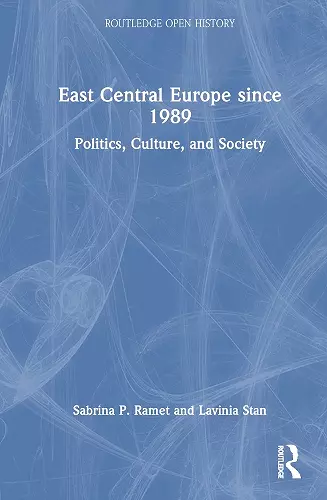East Central Europe since 1989
Politics, Culture, and Society
Sabrina P Ramet author Lavinia Stan author
Format:Paperback
Publisher:Taylor & Francis Ltd
Published:12th Dec '24
Currently unavailable, and unfortunately no date known when it will be back

This groundbreaking treatment of post-communist developments in East Central Europe examines politics, economics, media, religious institutions, transitional justice, gender inequality, and literature, highlighting the overt functions, latent functions, and side effects associated with each sphere.
Communism in East Central Europe had cracks from the beginning, as uprisings in East Germany in 1953 and Hungary in 1956 demonstrated. But with the establishment of the Independent Trade Union Solidarity in Poland in the Summer of 1980, communism went into steady decline and, between 1988 and 1991, crumbled. What followed has been an unsteady transition to various forms of often corrupt pluralism with democracy doing best in the Czech Republic (with the exception of the years 2017–2021) and Slovenia, and worst in Hungary, Albania, Serbia, and Bosnia-Herzegovina. Drawing on the functionalist theory of Robert K. Merton, the authors examine what policymakers – communist and post-communist – were or are trying to accomplish, the intended and unintended results of these policies, and the side-effects they have produced.
This volume will be of interest not only to specialists in East Central Europe but also to graduate and undergraduate students, members of the diplomatic corps, and general readers.
“Sabrina P. Ramet and Lavinia Stan combine their inexhaustible scholarly talents and experience to examine what communist and post-communist policymakers ‘have been trying to accomplish and what the intended and unintended results of their policies were, or what side-effects were produced by their policies.’ In ten well thought out, easily readable chapters, Ramet and Stan examine the deliberate and unintentional consequences of policies on a gamut of topics. The Ramet/Stan book is a highly readable, multi-topic approach to East Central Europe’s more recent past and present.”
—Peter Gross, Professor Emeritus and former Director of the School of Journalism & Electronic Media, University of Tennessee, USA
“This is an excellent and original book about a subject that is frequently touched upon but rarely explored from a position of such expertise. The authors’ multi-dimensional thematic study beautifully complements the narrative history of the prequel volume, to produce a work that no serious scholar of East Central Europe should be without.”
—Marko Attila Hoare, Associate Professor at the Department of Political Science and International Relations, Sarajevo School of Science and Technology, Bosnia and Herzegovina
“This book offers sophisticated and comprehensive analyses of the complex historic changes in East Central Europe over the past decades written by two of the most experienced and knowledgeable scholars of the field. The scope of the book includes discussions from institutions to practices and attitudes. Ramet and Stan invite us to get a closer look at the vicissitudes of the Yugoslav war and the concept of transitional justice as well. This is a must-read for students of European history and politics who want to understand the political labyrinth between pluralism and populism.”
—András Bozóki, Professor of Political Science, Central European University, Vienna
“This book is an elegant and insightful comparative overview of post-1989 Central Eastern and Southeastern Europe. Examining themes such as religion, media, gender, politics, and economy allows for rich perspectives on the region. It makes for an excellent introductory overview for students of post-Communist Europe.”
—Florian Bieber, Professor of Southeast European History and Politics, University of Graz, Austria
ISBN: 9781032319209
Dimensions: unknown
Weight: 750g
388 pages